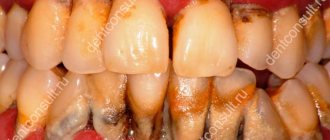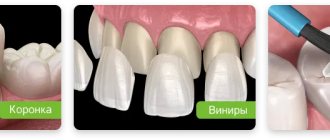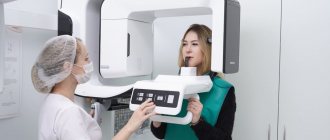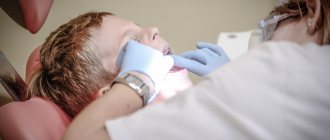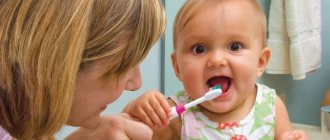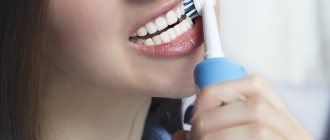To maintain dental health at any age, daily oral hygiene is extremely important. It would seem a simple procedure that does not take much time and does not require any extraordinary skills and efforts. But sometimes even adults are too lazy to do it regularly. What then can we say about kids? They don't even suspect such a need. How to teach a child to brush their teeth every day - morning and evening? What parenting tricks can you use to achieve the best results?
Baby 1 year old
At 1-2 years old, a child cannot yet brush his teeth on his own. But in order to develop a stable habit, this procedure can be carried out by parents until the baby grows up a little.
According to dentists, a child should start brushing his teeth when the very first ones have just erupted. For some it happens earlier, for others later.
But when the baby turns 1 year old, he definitely already has a couple of teeth in his mouth. And they require proper care. While the child does not know how to brush his teeth on his own, one of the parents does it for him using a special silicone brush.
Carry out this procedure regularly after your baby wakes up in the morning and before bed. This will be the initial stage of teaching a child to mandatory and regular brushing of teeth. And when your baby gets a little older, you can safely start teaching him to brush his teeth on his own.
Regularity is the key to effectiveness
Cleaning is of utmost importance. This hygiene procedure must be carried out regularly.
Moreover, if you perform care only once a day in the morning or evening, it will not be possible to eliminate the harmful effects of microorganisms. They actively multiply on the remains of consumed food and have an extremely negative effect on the condition of dental elements.
Without proper oral care, plaque appears, which gradually hardens and becomes tartar. Stone formations put pressure on the gum tissue, provoking the occurrence of an inflammatory process.
In addition, neglect of the rules of oral hygiene causes caries. This disease is fraught with serious consequences. In addition to pain, unpleasant odor and dental problems, various pathologies can develop in the human body. Since the rapid growth of the number of bacteria on damaged elements leads to their spread to internal organs. Because of this, numerous diseases appear.
To avoid such developments, it is necessary to clean the plates daily (2 times a day). You need to devote a sufficient amount of time to this process. Do not forget that neglect of your own health is unacceptable.
Child 4-5 years old
By the age of 4-5, many toddlers have already developed a stable habit of brushing their teeth. And parents can begin to draw their attention to the quality of the procedure.
Be patient. You are unlikely to be able to immediately teach your child to take care of his teeth. And that's okay. Moreover, for several more years (approximately until the toddler reaches school age) you will have to control the process itself. Since the baby still cannot properly brush his teeth on his own.
Pastes for children with stomatitis
Stomatitis occurs quite often in children. It is much easier to prevent the occurrence of a disease than to treat it later.
High mucosal immunity is the best protection against stomatitis. Enzymes (lactoferrin, lysozyme, etc.) included in the composition of children's pastes from SPLAT: Junior and Juicy Set have a beneficial effect on the immune system.
Recommendations for parents
- Brushing your teeth should not be a routine task for your child. Let it be in a playful way. So that the baby wants to repeat the procedure again and again.
- At the initial stage of your child’s education, your priority is to develop a habit, and not to teach the correct manual skills (how to hold a brush and how to move it, how long to brush your teeth, etc.). First, the baby must understand the importance of what he is doing, become interested, be inspired, and only then begin to follow the process itself.
- Therefore, after your little one brushes her teeth, be sure to check the result and clean them. Explain that not all evil caries were driven away by the child. Next time, let him try to reach with a brush all the nooks and crannies where they might be hiding.
Your child’s healthy, white-toothed smile in the future depends entirely on your patience, your perseverance and responsibility in the present.
Forming your child’s skills and established habit of brushing their teeth depends entirely on you. Be patient and moderately persistent. Your reward will be your child’s beautiful and happy smile for many, many years. And the knowledge that it was you who helped preserve this white-toothed smile.
Which pasta should you choose?
Before buying toothpaste, many modern parents go online to read reviews, but you shouldn’t trust them: many reviews are left on request in order to increase sales. The advertising is aimed primarily at women, since they are usually the ones who buy such things.
The main myth that can often be found in such reviews is the enormous harm of fluoride for children.
Fluoride or calcium: which is better for a child?
Fluoride is not poison at all. This substance is beneficial, including for children. Dental societies in many countries around the world have conducted studies that have proven that fluoride-containing toothpastes are absolutely not harmful.
You can often see that children should use a paste containing calcium, but this is not at all true.
When choosing pasta, you need to take into account the age of the direct consumer.
- Children under 1 year. This is the only age when it is better to purchase a paste with calcium in its composition, since during this period of time the tooth enamel is still quite weak and contains few minerals. Children often swallow the paste, so it should not contain parabens and sodium lauryl sulfate, which pose a health hazard. Fluoride-containing paste can be dangerous only where there is an increased fluoride content in the water: an excess of this substance can cause the development of fluorosis. If a filter is used, it can retain most of the fluoride, which will lead to its deficiency and, as a consequence, the development of caries. Read more about children's toothpastes here.
- Children from one to 6 years old. During this period, you can use a paste with fluoride, making sure that its content in the composition does not exceed 500 ppm. Pastes with calcium can also be used, provided that the child either does not have caries at all, or a single case of carious formation has been recorded.
- Children over 6 years of age. For children of this age, the concentration of fluoride contained in the paste should be increased to 1000 ppm.
Advice for parents who want to rid their child of dental problems:
- It is better to alternate different pastes: use a paste with calcium in the morning, and one with fluoride in the evening.
- You can get by with a calcium paste, but after each brushing, rinse your mouth with a special fluoride-containing liquid. Remember that such a liquid cannot replace a thorough cleaning!
Video “When should you start teaching your baby to brush his teeth?” Komarovsky
- Author: Polina
Hello. My name is Polina. Having once heard the truth that a pediatrician is the main doctor for any family with small children, I realized that I had something to strive for. Rate this article:
- 5
- 4
- 3
- 2
- 1
(1 vote, average: 3 out of 5)
Share with your friends!
Oral hygiene or rules for choosing toothpaste and brushes for a baby.
Where to celebrate New Year with a child (if the baby is only 1-2 years old)
Pastes to relieve painful symptoms during teething
There are several toothpastes designed to reduce the pain associated with teething.
In addition to the paste indicated at the very beginning of the article, we can recommend:
- Gel paste “Weleda” (Weleda) with calendula;
- ROCS Baby (ROKS Baby) with chamomile extract.
Both products will help your baby cope with pain.
At what age can you try to teach your child to brush their teeth on their own?
For your information! Gradually accustoming a child to independent oral hygiene should begin no earlier than one and a half years.
At this age, children often copy the behavior of adults, so it is easy to interest the baby with your own example.
However, parents should carefully monitor the baby's reaction.
If your first attempts at brushing your teeth on your own are accompanied by hysterics and screaming, it is better to postpone learning for a while.
It is highly undesirable to force your baby to brush his teeth..
Thus, it is possible to cause aversion to the procedure and fear of it.
What to do with teeth at 3 years old?
3 years is the age when it’s time to teach your child to brush their teeth consciously and independently. To do this, it is convenient to do this process in front of a mirror. Place your baby in front of the mirror and stand behind it.
Give him a toothbrush in his hand and place your hand on top.
Direct the brush in the desired direction, thereby teaching the desired technique.
Don't forget to rinse your mouth and spit out any remaining dirt and toothpaste.
Since the baby cannot yet independently assess whether he has brushed his teeth thoroughly, check it yourself. If there are any contaminants, then help him get rid of them.
What should a child's first toothbrush be?
The first toothbrush should be appropriate for the baby's age , be easy to use and have an attractive design.
So the baby is more willing to agree to brush his teeth.
It is worth noting! In addition, when choosing a device, experts advise parents to pay attention to the following criteria:
- ultra-soft synthetic bristles;
- rounded head shape;
- rubberized handle of optimal length (about 15 cm);
- presence of a safety circle;
- rubber brush for cleaning the tongue on the back of the head.
Modern children's toothbrushes are equipped with a musical timer that will notify the child during the procedure that it is time to move on to cleansing the other jaw.
Conclusion
Toddlers are truly capable of learning to brush their teeth on their own. And after reading this article about how to teach a child to brush their teeth, you can successfully instill this useful skill in your child.
The main thing is to make this process fun and interesting. An additional benefit of mastering the technique of brushing teeth will be the development of your child’s fine motor skills. Which is also important for the development of correct speech.
Dear parents, remember that your child’s health comes first. When your daughter or son grows up, looks in the mirror and sees a snow-white, beautiful smile, they will only say “thank you” to you! That's all for me. I look forward to your comments. Bye!
Dental care plan
To reinforce the effect, parents can create and print a colorful plan for brushing their teeth.
Then you need to hang it in the bathroom at the child's eye level .
This way, the child will not forget about the important stages of cleansing and will begin the task with interest.
The following items should be included in the plan::
- Rinse your mouth thoroughly with warm water from a glass.
- Squeeze a pea-sized amount of paste onto your toothbrush.
- First brush the upper teeth, then the lower ones.
- Connect the upper teeth to the lower teeth and brush in a circular motion on the outer right side.
- Now - the outer side on the left.
- Open your mouth and thoroughly clean each tooth from the inside.
- Stick out your tongue and brush it with the back of the toothbrush head.
- Rinse your mouth.
- Rinse the brush so that no paste remains on it and place it in a clean glass with the head facing up.
